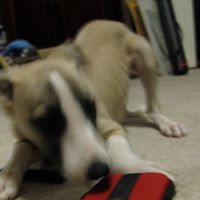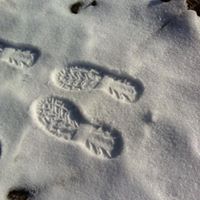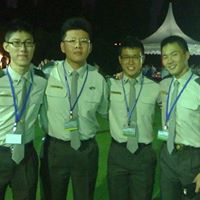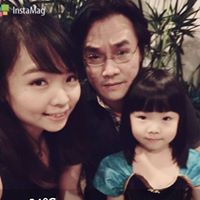Ling Kinh Yang
age ~44
from San Diego, CA
- Also known as:
-
- Ling K Yang
- Ling K Gieng
- Ling Kinh Gieng
- Long Sun Yang
- Long K Yang
- Long S Yang
- Lign K Gieng
- Lin Yang
- Kinh Yang Ling
Ling Yang Phones & Addresses
- San Diego, CA
- 1629 E 20Th St, Oakland, CA 94606 • 5106978661
- 1629 20Th St #E, Oakland, CA 94607
- Alameda, CA
- San Francisco, CA
- San Mateo, CA
Us Patents
-
System And Method For Detecting Errors In Audio Data
view source -
US Patent:20140040674, Feb 6, 2014
-
Filed:Aug 1, 2012
-
Appl. No.:13/564610
-
Inventors:Mark Pereira - Livermore CA, US
Ling Yang - Pleasanton CA, US
Govendra Gupta - Gandhi Nagar Jammu, IN -
International Classification:G06F 11/07
-
US Classification:714 49, 714E11024
-
Abstract:An application programming interface (API) executed by a first processing unit combines audio data samples with error code values generated for those samples. The API then causes a data stream to be opened having sufficient bandwidth to accommodate combined samples made up of audio data samples and corresponding error code values. The combined samples are then transmitted to a decoder and validation unit within a second processing unit that receives the combined data, strips the error code values and validates the audio data based on the error code values. When the error code values indicate that the audio data has been compromised, the second processing unit terminates the output of sound derived from the audio data.
-
System And Method For Detecting Errors In Audio Data
view source -
US Patent:20140040709, Feb 6, 2014
-
Filed:Aug 1, 2012
-
Appl. No.:13/564586
-
Inventors:Mark Pereira - Livermore CA, US
Ling Yang - Pleasanton CA, US
Govendra Gupta - Gandhi Nagar Jammu, IN -
International Classification:H03M 13/09
G06F 11/10 -
US Classification:714807, 714E11032
-
Abstract:An application programming interface (API) executed by a first processing unit combines audio data samples with error code values generated for those samples. The API then causes a data stream to be opened having sufficient bandwidth to accommodate combined samples made up of audio data samples and corresponding error code values. The combined samples are then transmitted to a decoder and validation unit within a second processing unit that receives the combined data, strips the error code values and validates the audio data based on the error code values. When the error code values indicate that the audio data has been compromised, the second processing unit terminates the output of sound derived from the audio data.
-
Nuclear Fuel Particles
view source -
US Patent:42670195, May 12, 1981
-
Filed:May 10, 1978
-
Appl. No.:5/904518
-
Inventors:James L. Kaae - Solana Beach CA
George H. Reynolds - Houston TX
Stewart A. Sterling - San Diego CA
Ling Yang - La Jolla CA -
Assignee:General Atomic Company - San Diego CA
-
International Classification:G21C 306
-
US Classification:176 82
-
Abstract:Coated nuclear fuel particles are made by first pyrolytically depositing low density carbon onto fuel cores and thereafter depositing a fission-product retentive, higher density exterior coating. In the improvement, cores of uranium, thorium or plutonium oxides are coated by co-depositing silicon carbide or zirconium carbide along with the low density pyrocarbon to create a uniform dispersion. Silicon or zirconium is deposited in an amount equal to at least about one atom for each fission anticipated during the fuel lifetime.
-
Method And Apparatus For Coating Fragile Articles In A Fluidized Bed Of Particles Using Chemical Vapor Deposition
view source -
US Patent:44864736, Dec 4, 1984
-
Filed:Sep 21, 1983
-
Appl. No.:6/534369
-
Inventors:James L. Kaae - Solana Beach CA
Terry D. Gulden - La Jolla CA
Ling Yang - La Jolla CA -
Assignee:GA Technologies Inc. - San Diego CA
-
International Classification:C23C 1100
-
US Classification:427249
-
Abstract:A massive article is coated by chemical vapor deposition in a chamber having a horizontal cross-sectional configuration generally matched to the horizontal cross-sectional configuration of the article. For an article which is relatively thin between a pair of opposed faces so that the article is subject to breakage by the force of surging particles of a fluidized particle bed, breakage is reduced in a coating chamber having vertical sidewalls that generally parallel the faces of the article and relatively narrow endwalls. The article is centered in the chamber with its faces parallel to the sidewalls leaving a region between the faces that accommodates an adequate flow of carrier gas and coating vapor without requiring a large charge of particles that would create undue surging force against the article.
-
Method Of Producing Spherical Lithium Aluminate Particles
view source -
US Patent:44055951, Sep 20, 1983
-
Filed:Jan 15, 1982
-
Appl. No.:6/339697
-
Inventors:Ling Yang - La Jolla CA
Russell R. Medico - San Diego CA
Wesley A. Baugh - San Diego CA -
Assignee:GA Technologies Inc. - San Diego CA
-
International Classification:C01F 704
-
US Classification:423600
-
Abstract:Spherical particles of lithium aluminate are formed by initially producing aluminum hydroxide spheroids, and immersing the spheroids in a lithium ion-containing solution to infuse lithium ions into the spheroids. The lithium-infused spheroids are rinsed to remove excess lithium ion from the surface, and the rinsed spheroids are soaked for a period of time in a liquid medium to remove water and NH. sub. 4 OH from their surfaces. The soaked spheroids are then dried and sintered to form lithium aluminate spherical particles.
-
Stacking-Port Configuration Using Zero-Touch Provisioning
view source -
US Patent:20210211351, Jul 8, 2021
-
Filed:Dec 17, 2020
-
Appl. No.:17/124799
-
Inventors:- Suwanee GA, US
Ling Yang - Pleasanton CA, US
Vignesh Hariharan - Fremont CA, US
Robin S. Wong - Alamo CA, US -
Assignee:ARRIS Enterprises LLC - Suwanee GA
-
International Classification:H04L 12/24
H04L 12/423
H04L 12/935 -
Abstract:An electronic device includes multiple networking devices arranged in a stack. The networking devices may include configurable ports, where a given configurable port in the configurable ports may be configured as a data port or a stacking port. During operation, a networking device in the stack may be designated as a master in the stack. In response, the networking device may provide one or more probe messages to determine a state of the networking devices, where the state includes one or more connections among the networking devices. Then, the networking device may verify that the one or more connections are correct. When the one or more connections are correct, the networking device may define a subset of the configurable ports in the networking devices as stacking ports.
Name / Title
Company / Classification
Phones & Addresses
HONG KONG RESTAURANT OH, INC
TRUE VAPES INC
Nueva Vista Investments, LC
Investments
Investments
506 Loch Lomond Ct, Milpitas, CA 95035
Lawyers & Attorneys

Ling Yang - Lawyer
view sourceAddress:
Barclays Capital Asia Limited
29032775xx (Office)
29032775xx (Office)
Licenses:
New York - Currently registered 2002
Education:
Notre Dame
License Records
Ling Yang
License #:
05133 - Expired
Category:
Accountants
Issued Date:
Dec 20, 2009
Expiration Date:
Jun 30, 2010
Type:
Certified Public Accountant
Classmates

Cambridge Rindge & La...
view sourceGraduates:
Marianne Szulewski (1971-1975),
David Weston (1982-1986),
Ling Yang (1983-1987),
anthony santoro (1975-1979),
Robert Robert grant (1945-1949)
David Weston (1982-1986),
Ling Yang (1983-1987),
anthony santoro (1975-1979),
Robert Robert grant (1945-1949)
Youtube
Flickr

Ling Ling Yang
view source
Pei Ling Yang
view source
Ling Yang Yang
view source
Mei Ling Yang
view source
Bao Ling Yang
view source
Ling Yang Chang
view source
Ling Yang Feng
view source
Ling Wen Yang
view sourcePlaxo

Ling OU YANG
view sourceProject Manager at KONE
Googleplus

Ling Yang

Ling Yang

Ling Yang

Ling Yang

Ling Yang
Relationship:
Single

Ling Yang

Ling Yang

Ling Yang
Get Report for Ling Kinh Yang from San Diego, CA, age ~44













